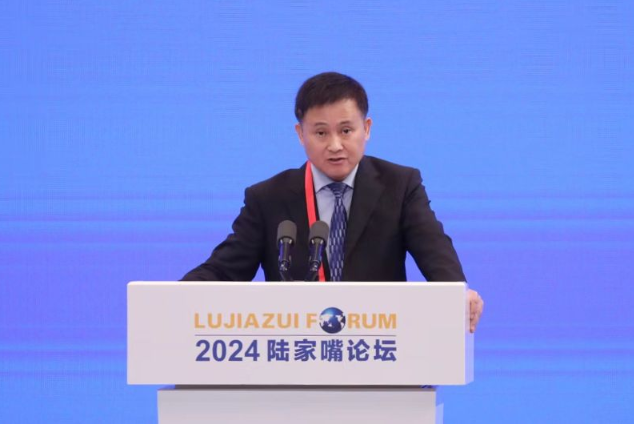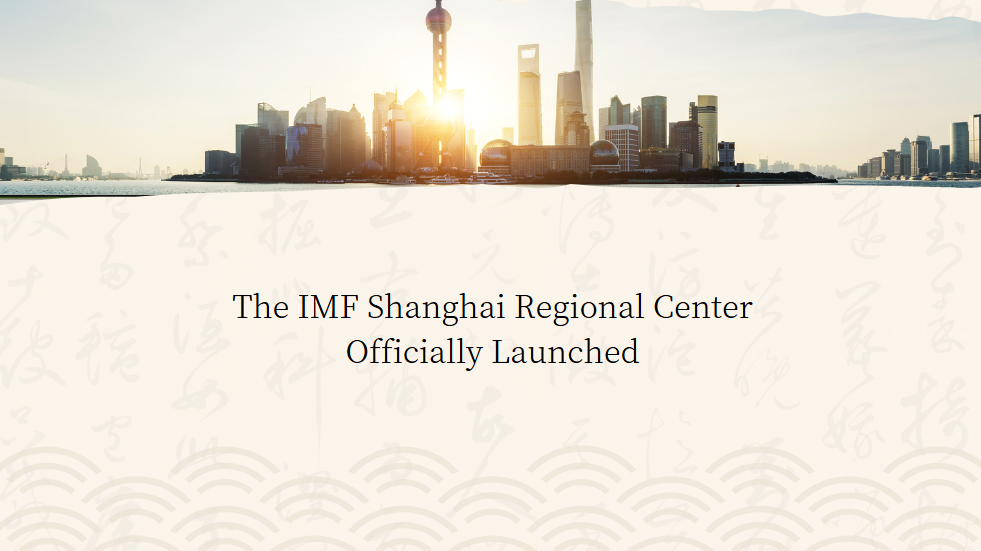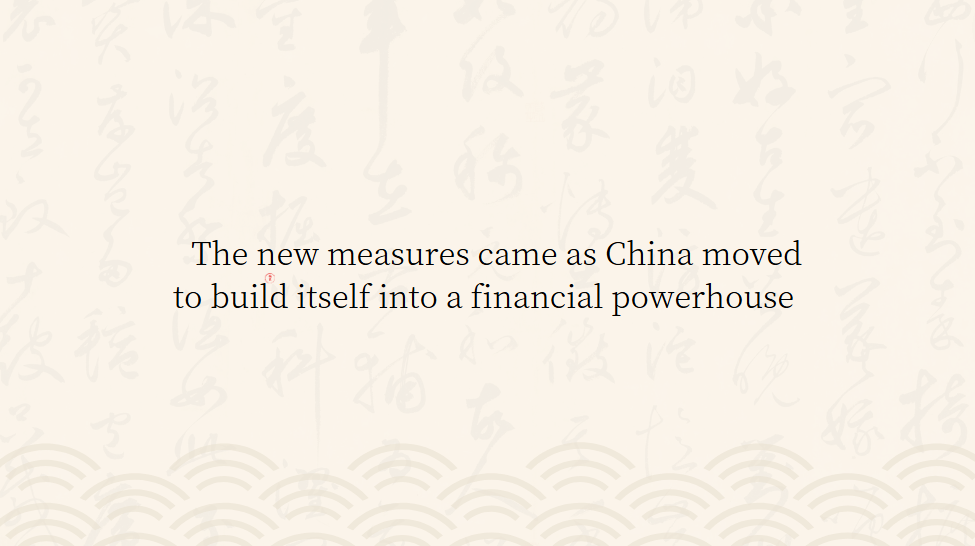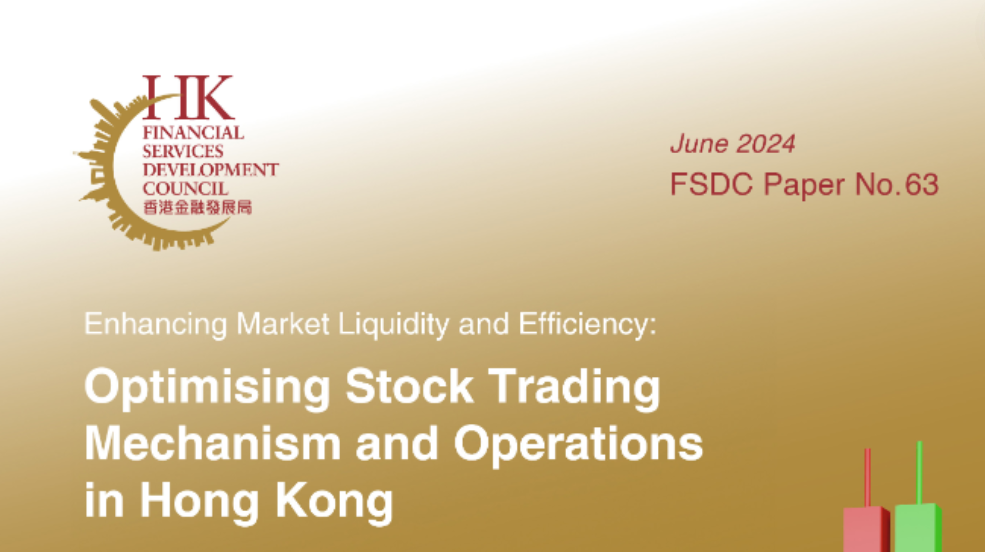China's Current Monetary Policy Stance and Evolution of Monetary Policy Framework in the Future
Distinguished Party Secretary Chen Jining, Mayor Gong Zheng, Deputy Director Wang Jiang, Minister Li Yunze, Chairman Wu Qing, Administrator Zhu Hexin, and dear guests,
Good morning!
It's a great pleasure to join you at the Lujiazui Forum. Supporting the development of Shanghai as an international financial center, and encouraging foreign financial institutions and international financial organizations to settle in Shanghai is a major task for the PBOC to implement important instructions of General Secretary Xi Jinping as well as the decisions and arrangements of the CPC Central Committee.
We witnessed the ceremony to launch the IMF Shanghai Regional Center just now. The IMF is an international financial organization of global significance. We are confident that Shanghai Regional Center will deepen the cooperation between the IMF and China, enhance macroeconomic policy exchanges and coordination among countries in the Asia Pacific region, and safeguard global and regional financial stability.
The PBOC will work together with Shanghai Municipal Government, relevant departments, and market institutions to support, as always, the development of Shanghai as an international financial center and expand the high-level opening-up of the financial sector.
Today, I would like to take this opportunity to have exchanges with you on issues related to China’s current monetary policy stance and the evolution of monetary policy framework in the future.
I. Current monetary policy stance
Since the beginning of this year, the global inflation has started to cool down, but it is still strongly sticky. Some central banks such as the ECB have begun their rate cuts while some others are still observing the developments and may cut rates later this year. On the whole, central banks remain unchanged with their high interest rates and restrictive monetary policy stance. China differs somewhat from them. Our monetary policy stance is accommodative, providing financial support for the continuous economic recovery.
In terms of the aggregates of monetary policy, the PBOC has adopted a variety of monetary policy instruments, such as cutting the required reserve ratio and policy rates, and bringing down market rates such as the loan prime rates (LPR), which created a favourable monetary and financial environment for the high-quality development of the economy.
At May-end, the year-on-year growth rate of the aggregate financing to the real economy (AFRE) and M2 registered 8.4 percent and 7 percent, respectively, both higher than the nominal GDP growth rate of 4.2 percent in the first quarter of this year. The interest rate on new loans issued in May stood at a relatively low level of 3.67 percent.
Concerning the structure of money and credit, the PBOC gave full play to the role of macro-prudential policies and structural monetary policy instruments. We have initiated the central bank lending for sci-tech innovation and technological transformation, which aims to enhance financial support for sci-tech innovation and equipment upgrading and renovation. We have launched a package of policies to support the real estate sector, including lowering the minimum down payment ratios for individual’s commercial housing mortgages, abolishing the mortgage floor rates, and cutting the interest rate on personal housing provident fund loans. We have also set up the central bank lending for affordable housing, to accelerate destocking commercial properties in a market-based manner.
Currently, outstanding structural monetary policy instruments register around RMB7 trillion, accounting for about 15 percent of the balance sheet of the PBOC. The instruments were set to support key areas and week links of the national economy, such as the development of micro and small businesses and green transformation.
Regarding the transmission of monetary policy, we have made efforts in regulating market behaviors, making better use of existing low-efficient financial resources, enhancing the efficiency of fund use, thus smoothing the transmission of monetary policy.
Since the beginning of this year, we worked together with the National Bureau of Statistics to improve the accounting method of the quarterly value-added of the financial sector. The accounting method has been adjusted from reckoning based on the growth of deposits and loans to income-based, which more truthfully reflects the value-added of the financial sector, and weakens the impulses of some local governments and financial institutions to shoot up deposits and loans at crucial time points. Meanwhile, After decades of operation as commercial and market-based entities, some financial institutions are still obsessive about scale expansion. They expanded their scale through undue and irrational competition, which was not supposed to happen. We regulated some market behaviors that are irrational or may undermine the transmission mechanism of monetary policy. For example, we promoted a balanced supply of credit, reduced and prevented the circulation of funds within the financial system, and rectified the behavior of luring depositors with manual interest subsidy.
In the short term, these regulatory measures will have the effect of “squeezing water” out of the financial aggregate data, but that does not stand for a shift in the monetary policy stance. Instead, it will help us more in improving the efficiency of monetary policy transmission, achieving a balanced pace of credit growth, alleviating the distortions in resource allocation, easing the problem of circulating funds for the sake of arbitrage, and forestalling and defusing financial risks. It will also be conducive to providing high-quality financial services for economic and social development as well as the healthy development of financial institutions and financial markets.
As for exchange rates, the RMB exchange rate has remained basically stable in complicated circumstances. Entering this year, we have seen the major advanced economies postponing once and again their timing of monetary policy reversal. Meanwhile, the China-U.S. interest rate spread has continued to be relatively high. Letting the market play a decisive role in the formation of exchange rates, we have maintained the flexibility of the exchange rate while strengthening guidance of expectations and taking firm steps to prevent the risks of exchange rate overshooting.
Through sustained effort over the years, China’s foreign exchange market has achieved substantial progress and development, with market participants becoming more mature and transacting in a more rational manner. An increasing number of business entities are using the tools for exchange rate risk hedging. Moreover, as the RMB cross-border receipts and payments now account for 30 percent of trade in goods, the exposure of enterprises to currency exchange risks has been reduced. We are also more experienced in coping with foreign exchange market fluctuations. As major economies are gradually reversing their monetary policies this year and the dollar appreciation is weakening, the difference between the monetary policy cycles at home and abroad is narrowing. These factors combined will help keep the RMB exchange rate basically stable and balance cross-border capital flows, thereby gaining more space for China’s monetary policy maneuvers.
Looking ahead, while undergoing continued recovery, the Chinese economy is still confronted with some challenges, mainly in that the effective demand is still insufficient; there are blockages to domestic economic circulation, and the complexity, severity, and uncertainty of the external environment have risen significantly. Adhering to an accommodative monetary policy stance, we will strengthen counter-cyclical and inter-temporal adjustments, help consolidate and add momentum to the economic recovery, and create a favorable monetary and financial environment for economic and social development.
In the process, we will pay special attention to the handling of three sets of relationships. First, the relationship between short-term and long-term concerns. Maintaining price stability and pushing for a mild rebound in prices will be an important consideration. We will use interest rates, reserve requirements, and other policy instruments in a flexible manner while maintaining policy resolve and avoiding drastic policy swings. Second, the relationship between stabilizing growth and preventing risks. We will take a coordinated approach in balancing the provision of support for the real economy and the need to maintain the soundness of financial institutions. We will be committed to forestalling and defusing financial risks while promoting high-quality economic development. Third, the relationship between internal and external concerns. In conducting the regulations, we will focus primarily on domestic economic and financial conditions while taking into account the spillover effects from the economic and monetary policy cycles of other economies.
II. Some thoughts on the evolution of future monetary policy framework
Based on years of practice and exploration, the monetary policy framework with Chinese characteristics has preliminarily taken shape and witnessed continuous improvement. Globally, explorations into the theory and practice of monetary policy have also been evolving. Since the beginning of this year, in light of the changing situation, the European Central Bank and the Bank of Japan have adjusted successively their monetary policy frameworks. Meanwhile, the Bank of England has conducted a review of its policy making, forecasting, and communication. To better serve the needs of high-quality development, we are also conducting research on China’s future monetary policy framework.
First, we will optimize the intermediate target variables for monetary policy. As prescribed by law, the ultimate objective of China’s monetary policy is to maintain the stability of the currency value and thereby promote economic growth. To achieve the ultimate objective, we need to keep an eye on and target some intermediate variables in the execution of monetary policy. While price-based regulation is prevalent in most of the major advanced economies, China adopts a combination of quantity- and price-based regulatory measures.
Traditionally being quite attentive to the indicators of financial aggregates, we have made continuous improvements and adjustments. In recent years, specific quantitative targets are set no more in our monetary policy for the growth rates of financial aggregates, such as M2 and social financing. They have been replaced by qualitative descriptions such as “being basically aligned with nominal economic growth”.

The monetary and credit growth as needed by the real economy is also changing with high-quality economic development and structural transformation. The changes in the growth rates of monetary and credit aggregates essentially reflect the structural changes in China’s economy and the associated supply-side structural changes in China’s financial sector.
When we look at aggregates from a mathematical perspective, the growth rate is the ratio of the current increase to the total existing amount, with the former being the numerator and the latter the denominator. Currently, as the outstanding amount of social financing in China has exceeded RMB390 trillion and M2 stands at over RMB300 trillion, China’s macro financial aggregates are huge. However, we should be aware that many of the existing loans are being used with low efficiency, mobilizing such loans is essentially as significant to economic growth as issuing new loans.
In terms of the changes in the credit structure, of the outstanding loans totaling almost RMB250 trillion, real estate loans and local financing vehicle loans account for a large share, which is declining rather than expanding. Only after having offset the decline, can the increase in other loans be reflected. As a result, it is quite difficult to maintain an overall credit growth of over 10 percent as seen in the past.
The measurement of money supply should also be improved constantly to adapt to the changing situation. China’s statistical coverage for M1 was set 30 years ago. With the facilitation of financial services and the rapid development of financial markets and financial innovations such as mobile payment, major changes have taken place to the range of financial products that meet the statistical definition of money supply, particularly that of M1, entailing dynamic improvements to the statistical coverage of money supply. Judging by the functions of money, we should work on incorporating in M1 statistics personal demand deposits and some highly liquid financial products, which can be even used to make direct payments, so as to better present a true picture of money supply.
We can also continue to refine intermediate variables for monetary policy, and gradually weaken our focus on quantitative targets. When the growth of money and credit has pivoted from supply constraints to demand constraints, it obviously runs against the law of economic performance if the emphasis remains on quantitative growth, or even “the obsession with aggregates” exists. Financial aggregates are to be viewed more as indicators for monitoring, reference and projection, and the role of interest rates in economic regulation should be more highlighted.
Second, we will further improve the market-based system for interest rate regulation. We have liberalized interest rates in recent years, and basically set up a mechanism for their formation, regulation, and transmission. From central bank policy rates to benchmark market interest rates, and then to various financial market interest rates, they witnessed relatively smooth transmission in general.
There is still room for improvement. For instance, a large variety of central bank policy rates exist, and the relationship among the interest rates of various monetary policy instruments is rather complex. Certain central bank’s short-term operational rate can be specified as the main policy rate, and the 7-day reverse repo rate basically fulfills this function. Therefore, the interest rates on other monetary policy instruments with different tenures may soften their roles as policy rates, and the transmission from short-term to long-term interest rates should gradually become smoother. Meanwhile, continued efforts will be made to reform and improve the LPR. Targeting that some LPRs significantly deviate from the actual prime rates for clients, the focus is on improving the LPR to more truthfully reflect the level of interest rates on the lending market.
Central banks usually use the interest rate corridor as a supportive resource in steering short-term interest rates, “binding” money market interest rates into a certain range. China’s interest rate corridor has now taken initial shape, with the SLF rate as a ceiling and the rate on excess reserves as a floor. The width is relatively large, which is helpful to leverage the role of market in pricing and stays resilient and flexible enough.
Recent movements of money market interest rates show that market interest rates have been running stably around policy rates, with significantly narrowed fluctuations. If we give greater play to the role of interest rate regulation in the future, we need, and we have the condition to signal a clearer target to assure the market. In addition to the clarification of the main policy rate, an appropriately narrowed interest rate corridor may also be needed.
Third, we will gradually include the purchase and sale of China government bonds on the secondary market in our toolkit. Recently, the market has paid more attention to this. We have been enriching and improving our methods for the injection of base money. And over a certain period in the past, the injection was passive through funds outstanding for foreign exchange. Since 2014, as such funds declined in amount, we have acted proactively to inject base money through open market operations and MLF, among other tools.
In recent years, the size and depth of China’s bond market enhanced with the rapid development of its financial market. So the conditions have been mature for the central bank to inject base money through the purchase and sale of China government bonds on the secondary market. It was noted at last year's Central Financial Work Conference that we should enrich our monetary policy toolkit and gradually include China government bond buying and selling in open market operations. The PBOC is now increasing communication with the Ministry of Finance to promote joint research on the implementation. The whole process is gradual, and the research on how to improve the issuance pace, term structure, and depository system for China government bonds is to be conducted at the same time.
It should be noted that including China government bond buying and selling in the monetary policy toolkit does not mean quantitative easing. Instead, it is meant to be a channel for base money injection and a tool for liquidity management. The China government bond transaction, both sale and purchase, will play its role together with other tools and create a suitable liquidity environment.
Rapid development of the financial market poses new challenges to the central banks. The failure of Silicon Valley Bank reveals that central banks need to observe and evaluate the financial market situations from a macro-prudential perspective, and correct and intercept the accumulation of market risks in a timely manner. At present, central banks should give special attention to maturity mismatch and interest rate risks arising from the large holding of medium- and long- term bonds by non-banking institutions, aiming to maintain an upward sloping yield curve and to help the market provide positive incentives for investment.
Fourth, we will improve the structural monetary policy instrument system which is precise and moderate. Traditionally speaking, the monetary policy adjusts aggregate. However, many problems and challenges in China’s economic development are structural. If they are not properly solved, the effectiveness of aggregate adjustment will be restricted. Around the world, since the global financial crisis, especially in response to COVID-19 in 2020, central banks in the major economies, such as the US and the euro zone have launched a series of structural monetary policy instruments targeted for specific areas, entities and purposes.
We have been exploring how to leverage the guiding role of structural monetary policy instruments. And we have accumulated some experience and good practices in the process. For instance, structural monetary policy instruments should follow the principle of remaining targeted, reasonable, moderate, and flexible, and they are expected to be complementary to the aggregate instruments. By incorporating incentive mechanisms into the structural instruments, we guide financial institutions to optimize credit structures in a market-oriented way while guarding against moral hazards.
In the future, when using structural monetary policy instruments, we will continue to properly use and enrich the experience we have accumulated and improve relevant institutional frameworks. We will appropriately manage the scale of structural instruments and withdraw those that have reached their temporary goals in a timely way.
Fifth, we will enhance the transparency of monetary policy and improve the policy communication mechanism which is reliable, regular, and institutionalized so as to ensure effective policy communication and expectation guidance. An important feature of the modern monetary policy framework is that central banks can communicate with the market and the public about policy considerations and prospects in a transparent, clear, and timely manner. Enhanced transparency will make policies more understandable and authoritative, and the market will hence have a stable expectation for the policy trend in the future and adjust its decision-making accordingly. In this way, monetary policy adjustments will achieve multiplier effects. My speech today is exactly an effort towards this goal and we will make continuous effort to do a good job in central bank communication.
Last but not least, I'd like to wish 2024 Lujiazui Forum a complete success. Thank you.






















































First, please LoginComment After ~